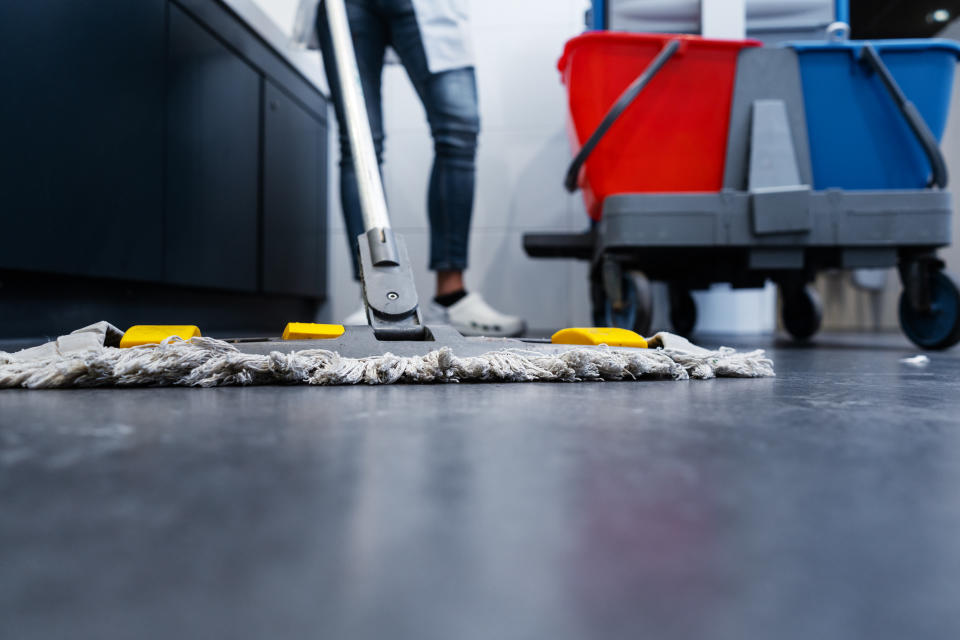Restaurant manager dies after exposure to toxic chemicals: What to know about mixing cleaning products

A 32-year-old man has died after working with common cleaning products in the kitchen at a Buffalo Wild Wings restaurant near Boston.
Thirteen other people became ill following a chemical reaction at a Massachusetts franchise of the fast-casual chain.
Ryan Baldera, the branch’s general manager and a recently married father to a newborn son, is being heralded as a hero for trying to save other people from toxic fumes.
ALSO SEE: How to recognize the signs of a severe asthma attack
According to the Boston Globe, another worker had applied Super 8—a concentrated liquid chlorine bleach—to the floor to clean it. Apparently, the worker wasn’t aware that an acid-based general-purpose cleaning agent called Scale Kleen had previously spilled in the same area.
When the two substances combine, they create poisonous chlorine gas.

Baldera was apparently trying to push the products out of the restaurant using a squeegee when he was overcome by noxious fumes.
He collapsed and was rushed to a nearby hospital, where he later died. Thirteen other people, both workers and customers, were hospitalized for difficulty breathing and burning sensation in the eyes.
“While devastated at this unimaginable loss, we are so very proud that Ryan died while trying to protect his fellow employees and restaurant patrons," Baldera's family wrote in a statement.
ALSO SEE: What The Health?! Woman removes four live worms from her eye after jogging
Baldera’s obituary read: “He left this world doing what came so naturally to him; trying to help others.”
Bleach is nearly always the culprit in these kinds of incidents, says Laurel L. Schafer, professor in the department of chemistry at the University of British Columbia in Vancouver and Canada Research Chair in Catalyst Development.
“The rule of thumb is: Do not mix bleach with anything except water,” Schafer tells Yahoo Canada. “Some products do not call their product bleach, but we all know what bleach smells like, and the label will read sodium hypochlorite.”

“It is the hypochlorite part that can be dangerous if a chemical reaction occurs,” she says. These reactions can evolve dangerous fumes, so confined, poorly ventilated spaces are particularly dangerous.”
The effort to clean up the substances at Buffalo Bill’s likely resulted in the products being mixed together even more, leading to more toxic fumes.
If accidental mixing occurs, leave immediately and do not attempt to clean it up, Schafer says.
“Open all doors and windows to ventilate and leave the area to get fresh air as quickly as possible,” she says. “The chemical reaction is rapid and vigorous and will be over in a matter of minutes, say 10 to 20, depending upon the size of the spill.

“Once the area is fully ventilated you can return, but do not assume that there are no dangerous chemicals remaining,” she adds. “Instead, here dilution is the solution. So with extensive ventilation and ideally a respirator, add lots of water to the accident area, leave again, and wait some further time for toxic fumes to dissipate, and then clean up this diluted mixture.”
If you’ve been exposed to chlorine gas, the Centers for Disease Control and Prevention also recommends removing clothes rapidly, washing the body with soap and water, and getting medical attention.
ALSO SEE: What The Health?! Man dies after eating 42 hard boiled eggs
Death is rare from this kind of chemical reaction, she notes. More commonly, people will experience irritated nasal passages, throat, and lungs and “generally feel terrible for some time”, Schafer says.
Other symptoms from exposure include blisters, pain, or redness on the skin; coughing; chest tightness; nausea and vomiting; and wheezing.
Education is crucial to avoiding potentially dangerous situations involving these types of cleaners, Schafer says. No form of acid should ever be mixed with chlorine bleach, according to the Office for Science and Society at McGill. This includes acidic drain cleaners, rust removers, and even vinegar.
“This is preventable,” Schafer says. “People who work with hypochlorite cleaning products should be instructed to avoid mixing them with other cleaning products.”
Let us know what you think by commenting below and tweeting @YahooStyleCA!


